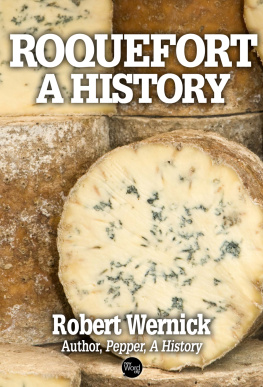Penicillium spores keep the town of Roquefort rich and redolent. It is the sole owner of one of the oldest protected product names in the world. The Parlement of Toulouse, the high court for southwestern France, decreed in 1666 that anyone presuming to sell a cheese described as Roquefort, which was not made in the town of Roquefort-sur-Soulzon according to the traditional methods of the trade, would be subject to a fine of a thousand livres. The laws are strict to this day. Any cheese labeled Roquefort must come from one of the thirtee producers whose caves are buried in the sides of the cliffs near the streets of the town. The Roquefort dressing you get on your salad must contain, if your restaurant is honest, fifteen percent of genuine cheese from these caves.
There is nothing arbitrary about this. Roquefort is, indeed, a unique product. Anyone can make a cheese with holes in it and call it Swiss. Anyone can mix mold with curdling milk and produce a cheese that he can call blue - though blue is a misnomer, the fault, perhaps, of some color-blind, medieval monk. The color is actually blue-green. But Roquefort is not to be confused with ordinary blue cheese. For one thing, it is made with ewes milk, not cows, and hence has a juicier texture. For another it is made under ideal conditions in a refrigerating and humidifying plant that would cost a millions to duplicate, but is provided in Roquefort-sur-Soulzon gratis by Mother Nature.
Several million years ago, accompanied by a series of thunderous roars, a huge chunk of the nearby causse, or limestone plateau, collapsed into the valley of the Soulzon, forming a jumble of blocks about a mile and a quarter long, more than 300 yards deep, piled up at all angles to one another like so many broken sugar cubes. There are spaces between these blocks, sometimes cracks as thin as a fingernail, sometimes corridors down which you could climb for a considerable distance, sometimes pits deep enough to drop your worst enemy down with no fear that he or she would ever come back to haunt you.
These cracks and pits and corridors are known in the local dialect as fleurines (from a verb meaning to blow) because of the cool air that blows out of them. The inhabitants of the region have been aware of these winds ever since Neolithic shepherds, 4,000 to 6,000 years ago, drove their flocks up from the plains of the Mediterranean coast to the upland meadows of the causse country. The land was, and is, rough, desolate, and wind-blasted. It will grow grain or grapes only with reluctance. But it proved to be good sheep country, and the wandering shepherds eventually settled down there. They probably prospered - at least if one may judge from the quantity of huge dolmens they erected near their sheep trails.
The shepherds who came to the valley of the Soulzon discovered the network of caves and fissures on the surface of the rockslide, and they could only have been intrigued by the breeze that rose steadily from them each summertime, offering refuge from the sun and the flies, as well as a good place to store their mutton and their bread and the cheese they had apparently learned to make by putting rennet (the stomach lining of lambs not weaned) into pots of ewes milk.
This cooling air flow, as later investigation would show, was the effect of an intricate wind system arising within the interlocking fleurines in the jumble of limestone blocks. The openings, facing north, are rarely touched by the sun. The winds bring rain that seeps down into a network of underground streams. Some of it, also, is retained by cavities in the porous rock. In winter, cold damp air sinks down. In summer, the rocks exhale their moisture, and cold damp air flows upward. What this all adds up to is a self-regulatory system, as precise as any computer could devise, which helps the temperature in the caves to remain constantly between forty-four and forty-eight degrees Fahrenheit (F). The relative humidity varies only a point or two from ninety-five percent.
Hardly an inviting environment. The tourist who visits the caves where the cheese is made today and sticks his nose into one of the fleurines may well think that the strong cold blast - strong enough to put out a candle - comes, like the wind in the ballad of Frankie and Johnnie, from the southeast corner of Hell. No animals choose to live here, though rats and sometimes dormice come down, lured by the smell of cheese. The fleurines are not quite lifeless, however. They provide a breeding ground for a tiny mold, PenicilliumRoqueforti, so called because this was the spot where the mold was first identified and where it flourishes most happily. For this little fungus, which is the secret of the taste of the cheese, by happy coincidence lives best in a moist habitat where the temperature generally hovers around fifty degrees F.
You can see little colonies of Penicillium glistening against the dark rock on any fleurine or any man-made wall inside the rockslide. Give it something to feed on, say, a piece of bread, and it reproduces itself at a fantastic rate. Under a microscope you can see its little fingers putting out reproductive spores - a strong microscope because these spores are so tiny that it takes hundreds of millions of them to fill a soup spoon.
The discovery of Penicillium roqueforti (which is only a distant relative of the mold that produces the antibiotic) may have been made in Neolithic days. One story favored by the local authorities is that a shepherd boy was one day loafing in a cool dark cave, about to eat a rustic lunch of bread and cheese, when he saw a shepherdess go by with her flock. Dropping his lunch, he raced out after her. What with one thing and another, it was several days before he returned. To his amazement he found that the bread was a mass of green mold and his cheese was all streaked and mottled. Wisely he left the bread alone but ate the cheese.
Finding it delicious he called in his friends, and soon every cave along the hillside had a cheese and a loaf of bread in it.
Albert Alric, a cheese maker in Roquefort, told me this pretty tale is romantic nonsense, and he has a more down-to-earth explanation. Despite his aristocratic name - which, by his perhaps lax genealogical standards, indicates that he is a lineal descendant of Alaric, the fifth-century king of the Visigoths and conqueror of Rome - Albert Alric is of peasant stock. He was brought up in a countryside where daily life had not changed much since Neolithic times. His grandmother used to go out to pasture with the sheep every day carrying a long leather whip to chase off wolves.
In Neolithic times, according to Alric, as in the days of his youth, all hands were needed in the field in summer, and bread could not be baked more than once every six weeks or so. If it is kept in cool hillside caves, bread tends to get moldy after six weeks. But in a peasant community, it is sacrilege to throw away bread, so the peasants went on doggedly eating it anyway until someone noticed that the stale slices tasted better with cheese on them. And a day came when one of those unknown geniuses, who open up new pathways for humankind, reasoned that instead of taking the cheese to the mold he could take the mold to the cheese. He mixed some moldy bread into the milk as it was coagulating. The result was something that not only tasted better but lasted longer than ordinary cheese.
The news of this discovery spread over the trade routes of old Europe. When the Romans built the great highway - the Via Domitia - that linked the Pyrenees with Italy, it passed not far from Roquefort, and it became relatively easy to send the cheeses to the seacoast and then by coastal shipping to Rome. The Romans, it seems, fell in love with Roquefort. Like all the Mediterranean peoples down to our own time, they were used to cheeses, most of which tended to be dry and hard. Roquefort, by contrast, was smooth and soft and tasty, and the Roman aristocrats were willing to pay high prices to have it on their tables. So, no doubt, were the Visigoths, who succeeded them, and then the Franks. The Emperor Charlemagne, it is said, used to have a pack-train of mules bring Roquefort to his court at Aix-la-Chapelle every Christmas. Rich landed proprietors, like the Knights Templars, who were once in charge of the area near Roquefort, received payments in cheese from local peasants.
Next page












